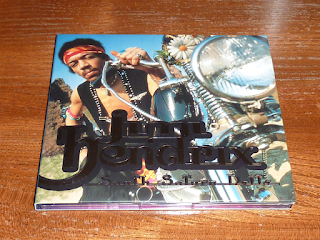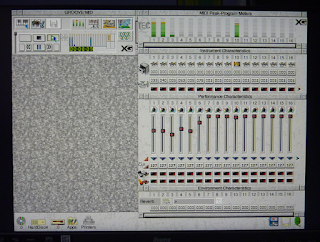At a glance, Escapade is a predominantly downtempo album, with 5 of its 7 tracks executed at 100 BPM or less. Chronicles of a Dead End redresses the balance in several ways: primarily, the addition of "One of My Goof Attacks" as a third fast number, the condensation of the "Escapes" into one piece, and the fact that this kind of music tends to feel faster when played on traditional instruments instead of MIDI.
Nonetheless, it's surprising to realize that "Look and See" is the only real ballad in the set. Near misses include "Modern Art" (deliberately unsentimental), "Faraway Island" (as Lynsey astutely put it, "upbeat but not forceful") and the Escapade 2-exclusive "After the Party" (just plain doesn't work as a full song).
Up to this point, I have largely kept the emotional pain behind so much of this album's material at arm's length in the lyrics. "Look and See" is the one song where I don't think that would work. Despite the theatrical character of the melody (a consequence, I think, of me not infrequently accompanying my music teacher's other students on piano in my early- to mid-teens), the Escapade 2 version demonstrates (in embryo, at least) that the best approach to this song is one of intense vulnerability.
Ironically, the song's extremely sparse presentation on Escapade 2 is a consequence of me, at the time, disliking the Escapade version and wanting as little to do with it as possible. This also resulted in by far the most extensive lyrical rewrite on 2. Now, matters are complicated by the fact that the Escapade version has grown greatly in my estimation in the years since those sessions, so we now have two very different versions of this song to draw on.
The key to the song, I think, lies in my favourite line on all of Escapade:
"Even if you say I'll lose my mind"
Who is this line addressed to? Everyone. In the situation I'm pretty sure this is about, basically everyone was telling me (with varying degrees of subtlety) that I was well down the rabbit hole. And startlingly, I realize all these years later that the naysayers included me all along! I really wanted to not be single, but 90% of my effort to remedy that consisted of racking my brains trying to figure out a way to ask out one of my friends that wouldn't just come off as weird... and failing to think of anything.
Clearly, I knew deep down that what I really needed to do was to go out and meet new people, but I literally did not feel safe doing so. I had been deeply shaken by the experience of (twice in just a few months) having a (debatably) hopeless crush rumbled by bullies to devastating effect, and concluded (I believe correctly) that nervousness was the reason why things weren't going too well for me. My crucial mistake was to conclude that the way out of this had to be by way of someone who wouldn't make me nervous. Oops.
The final verse, which is basically the first verse of the Escapade 2 version, switches the timeframe from the past to the present. This is potentially the turning point, not only of this song, but of the whole album. Interestingly, this juxtaposition of timeframes is very similar to an old friend: none other than Meat Loaf's "Paradise by the Dashboard Light" - also track 6 on a 7-track album!
Every day I'm waiting in line
For a friend to signal to go.
Even if you say I'll lose my mind,
How else could I know,
What is real? Look and see,
These feelings don't make sense to me,
But my mind is made.
Why do I have to go somewhere new?
It's happened twice before,
Someone sees and calls me such a fool.
So much for an open door.
I believe, look and see,
I only need one miracle,
And it will be good.
And then, look and see,
I won't go through that pain again,
But I'll make it out of here.
I knew that I was wasting my voice,
It seemed my only choice.
I had hoped it wouldn't come to this,
How could I get all the way home?
On a lighter note, a good thing to come out of this is that "One of My Goof Attacks" inspired me to finally listen to some posthumously released Hendrix! I went for South Saturn Delta, which seems to be quite highly regarded. There's not much I can say beyond "it's Jimi, and Jimi is cool"... except that the Bo Hansson cover "Tax Free" made me want to sing Van Halen's "Runnin' with the Devil" over it, and that "Midnight" sounds at times eerily similar to U2's later "Bullet the Blue Sky", of all things.
 |
The letters are shiny. So much for CD packaging being boring.
|


